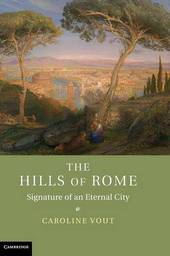
|
The Hills of Rome: Signature of an Eternal City
Hardback
Main Details
| Title |
The Hills of Rome: Signature of an Eternal City
|
| Authors and Contributors |
By (author) Caroline Vout
|
| Physical Properties |
| Format:Hardback | | Pages:320 | | Dimensions(mm): Height 254,Width 178 |
|
| Category/Genre | Art History |
|---|
| ISBN/Barcode |
9781107025974
|
| Classifications | Dewey:945.632 |
|---|
| Audience | | Professional & Vocational | |
|---|
| Illustrations |
1 Plates, color; 1 Maps; 26 Halftones, color; 57 Halftones, black and white; 15 Line drawings, black and white
|
|
Publishing Details |
| Publisher |
Cambridge University Press
|
| Imprint |
Cambridge University Press
|
| Publication Date |
13 September 2012 |
| Publication Country |
United Kingdom
|
Description
Rome is 'the city of seven hills'. This book examines the need for the 'seven hills' cliche, its origins, development, impact and borrowing. It explores how the cliche relates to Rome's real volcanic terrain and how it is fundamental to how we define this. Its chronological remit is capacious: Varro, Virgil and Claudian at one end, on, through the work of Renaissance antiquarians, to embrace frescoes and nineteenth-century engravings. These artists and authors celebrated the hills and the views from these hills, in an attempt to capture Rome holistically. By studying their efforts, this book confronts the problems of encapsulating Rome and 'cityness' more broadly and indeed the artificiality of any representation, whether a painting, poem or map. In this sense, it is not a history of the city at any one moment in time, but a history of how the city has been, and has to be, perceived.
Author Biography
Caroline Vout is Senior Lecturer in Classics at the University of Cambridge and a Fellow of Christ's College and the Society of Antiquaries of London. She is a historian and art historian who publishes on a wide range of topics related to Greek and Roman art and its reception, Latin literature and Roman history and is the author of Power and Eroticism in Imperial Rome (Cambridge, 2007). In 2009 she was awarded a Philip Leverhulme Prize for her work on art history and in 2010 was the Hugh Last Fellow at the British School at Rome.
Reviews'For tracing the history of a seemingly over-familiar idea Caroline Vout's book sets a new and high standard.' The Times Literary Supplement 'Vout is an established scholar of Roman visual culture with a penchant for integrating art and text, as well as material ancient and modern, to produce stimulating approaches to Roman cultural history. This book is no exception and demonstrates the sheer range of Vout's erudition ... provides a level of detail and sustained analysis of cultural geography that should serve as a model for future scholars of topography ... original and stimulating ... Throughout, the author demonstrates a skilled and sensitive analysis of both literary and visual material, and there are some truly eye-opening interpretations in the context of politics, religion and visual culture, both in the classical and post-classical city. It sets a new benchmark for the discussion of Roman cultural history and its reception. It is a rich tapestry of ideas, sophisticated and elegantly written, and makes a persuasive and compelling case that the seven hills are indeed the signature of the eternal city.' Mark Bradley, The Journal of Roman Studies 'The ambitious topic treated in this book is very well chosen and has a lot to offer. This book does a great deal in illuminating some aspects of the 'seven hills' concept and will prove useful for many advanced students of Rome ...' Raphael Hunsucker, Mnemosyne
|